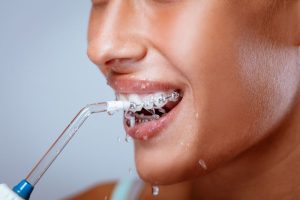Warm water is all you need for your Waterpik to efficiently clean your teeth. However, you might wonder if you can put mouthwash in a Waterpik. Is it safe to use, or will the mouthwash damage the water flossing unit?
In this article, we’ll go over the types of mouthwash you can use with a Waterpik water flosser and what types you should not use.
We hope this post will answer all the questions you might have about putting mouthwash in a Waterpik. Also, read our article about the best water flossers on the market.
In This Article
Best mouthwash to use in a Waterpik
Using mouthwash in a Waterpik water flosser can be a great way to clean your teeth and keep your breath fresh at the same time.
However, using the wrong mouthwash in your Waterpik can potentially damage the water flosser unit. Thus, it's important to know what mouthwash you can use and what types you should stay away from.
Standard mouthwash


Standard mouthwash is, according to Waterpik, safe to use in their water flosser. It’s an effective way to remove odors and refresh your breath.
To use standard mouthwash in your Waterpik, follow these instructions:
- Fill the reservoir with warm water and add a tiny bit of mouthwash. To avoid causing harm to the device, do not exceed a 1:1 mouthwash-to-water ratio.
- Water floss as directed in the Waterpik user manual
- After flossing, clean the device by filling the reservoir halfway with ordinary warm water and running it into the sink with the tip pointing down.
Therapeutic mouthwash
Gum disease can be treated using therapeutic mouthwash. These are typically prescription-only solutions that include the antibacterial medication chlorhexidine gluconate (CHX).
If you develop periodontal pockets as a result of gum disease, your dentist may prescribe cleaning them using a Waterpik water flosser that has a Pik Pocket tip.
To utilize therapeutic mouthwashes in a Waterpik water flosser, follow these steps:
- Add the therapeutic mouthwash according to the recommended ratio.
- Lower the pressure on the water flosser.
- Place the tip gently beneath the gum line and into the pocket.
- Turn on the water flosser and draw a line along the gumline.
- After flossing, clean the water flosser by filling it halfway with normal warm water and running it through the sink with the tip pointing down.
Antiseptic mouthwash
Listerine® and other antiseptic mouthwashes include alcohol and chemicals that inhibit the development of bacteria in the mouth. They're designed to aid in the prevention of gum disease and gingivitis.
To use an antiseptic mouth rinse, follow these instructions:
- Add no more than a 1:1 ratio of antiseptic mouthwash to warm water to the reservoir to avoid damage to the Waterpik water flosser.
- Water floss as directed in the Waterpik product instructions
- After water flossing, clean the Waterpik by filling the reservoir halfway with warm water and pouring it into the sink with the tip pointing down.
Here is a video of how to use a Waterpik:
What not to put in a Waterpik water flosser
Adding any of these mouthwashes to the reservoir of your water flosser might degrade performance and shorten the Waterpik‘s lifetime.


- Essential oils (tea tree oil, for example)
- Iodine
- Saline solution in cordless water flossers (it’s okay in countertop water flossers).
Conclusion
When it comes to your oral health, you should always seek the advice of a dental expert. It's a good combination to mix a mouthwash with water at a 1:1 ratio or less, but it hasn't been professionally evaluated to see whether there are any advantages beyond using warm water alone.
Nevertheless, mixing a little bit of mouthwash into the warm water you're filling in the Waterpik water flosser can provide some good health benefits for you, especially if you have braces or other unique requirements.
Did you know? — as long as it's very diluted and not used every day, you can also put hydrogen peroxide in a water flosser.
FAQ
Can you put mouthwash in a Waterpik?
Yes, you can use standard mouthwash, antiseptic, or therapeutic mouthwash. Some types of mouthwashes, like pure essential oils and iodine, are not recommended.
Can I put Listerine in my Waterpik?
According to Waterpik, it is safe to use Listerine and chlorhexidine in their water flossers. However, you must rinse the Waterpik device after flossing with mouthwash.
What is the best mouthwash for Waterpik?
Listerine and chlorhexidine are safe to use in a Waterpik water flosser. Also, a 1:1 ratio of any standard, antiseptic, or therapeutic mouthwash works well in a Waterpik.
Can you use mouthwash in a Waterpik?
Yes, you may use mouthwash, whether it's regular, antiseptic, or therapeutic. Some mouthwashes, like pure essential oils or iodine, are not suggested. After use, rinse the Waterpik with clean water.
How much mouthwash to use in a Waterpik?
Standard, therapeutic, and antiseptic mouthwashes are okay to use. However, mix it with warm water and do not exceed a 1:1 ratio. Make sure to clean the Waterpik after flossing with mouthwash.
Waterpik.com: Mouthwash and your Waterpik. Consulted 24th March 2022




